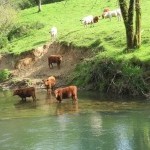Water Pollution Trading
Water pollution trading
Sometimes called water quality credit trading—is the concept that a pollution discharger with a permit can clean up someone else’s pollution instead of its own in order to meet its Clean Water Act permit limits. If this sounds like a dubious proposition, it’s because it often is. Generally speaking, not only should dischargers clean up their own pollution but the sources of polluted runoff—such as farmers and logging companies—should also reduce their very significant pollution contributions. If land owners retain their current expectations that someone else will always pay them to do the right thing, namely to stop polluting public waters, the nation’s waters will never be clean.
Of states in the Northwest, Oregon has the most experience with water pollution trading. Overall, as promoted by the Oregon Department of Environmental Quality (DEQ), trading is a method of undermining the Clean Water Act and helping polluters evade pollution controls. For example, Oregon DEQ develops clean-up plans, called Total Maximum Daily Loads (TMDLs), to allocate pollution control responsibilities among groups of polluters. A TMDL is like deciding first how big a pie to bake and then, second, cutting the pie up into pieces. The size of the pie is how much pollution a river can handle each day; the pieces of pie are about how much each pollution source can contribute to that total daily load.
In the most extreme examples of TMDLs, DEQ assumes that nonpoint sources, such as farming and logging, will make the maximum possible effort to limit pollution. They are given a piece of pie—an opportunity to contribute to the allowable amount of pollution—that is zero, nothing on the plate. DEQ never translates that assumption of zero pollution to what a land owner would actually have to do on the ground. However, it would start with providing the maximum amount of shade to any streams on the property, forested buffers that could be up to 100 feet or more.
Other practices would be necessary to make sure that, for example, erosion of soil did not swamp the buffers. Suffice it to say, not only are land owners not using these techniques to protect streams and rivers from polluted runoff and erosion, but state and federal agencies are not making them do that or, in some cases, anything at all.
Despite the total disinterest of states in regulating pollution from agricultural lands, and their inadequate regulation of logging activities, Oregon DEQ pretends that these land owners will make the maximum possible effort to control pollution. On the basis of this totally flawed assumption, DEQ gives all of the allowable pollution to the dischargers with permits, the only sources that are regulated under the Clean Water Act. So far, so bad.

NWEA has detailed the failings of Oregon water pollution trading schemes in letters to the U.S. Environmental Protection Agency (EPA). Among the concerns NWEA has expressed are the following:
1. Oregon’s trading program is driven by economics not environmental outcomes;
2. Oregon permits with trading provisions are riddled with ambiguity; and
3. issues of uncertainty have not been addressed.
